QUETICO PROVINCIAL PARK, ONTARIO
Marv Boerboom's fishing rod bent in half. ¶ He tugged as if he had hooked a log, but then twice line peeled off his reel and his rod tip quivered. ¶ After a short battle, he eased a chunky 27-inch walleye to the surface of the dark waters. It barely fit in our small landing net. ¶ "Holy cow, that was fun,'' said Boerboom, 64, of Alexandria, Minn. "That made the trip.''
It was the first of many big walleyes, northerns and smallmouth bass six of us caught on a recent nine-day trek into the center of Ontario's Quetico Provincial Park, just across the border from Minnesota's Boundary Waters Canoe Area Wilderness. We even landed a dozen lake trout.
Of course, the allure of this wilderness waterway is more than the fantastic fishing: There are dramatic rock cliffs, tall pines, idyllic campsites and ever-present loons. Not to mention golden-fried walleye, baked northern and pancakes made with fresh-picked blueberries.
As a bonus, we often paddled and camped in solitude; the only sound was the whistling of wind through the pines and the lapping of waves on the shoreline. We saw only a few other travelers.
"We have the whole lake to ourselves,'' Dave Swenson, 52, of Cotton, Minn., said after our first day fishing Conmee Lake, our primary destination. Swenson, a former Ely, Minn., fishing guide who organized the trip for his friends, knew of the lake's reputation for big fish.
"It's legendary,'' he said after catching and releasing a plump 29-inch walleye. Later, we caught several 36- to 38-inch northerns and 20-inch bass.
In Quetico, barbless hooks are required, and no live bait is allowed. That wasn't a problem. We used jigs with plastic minnows and twister tails — chartreuse, orange, black and silver worked well — and also caught fish on crankbaits.
But getting to fishing's Shangri-La wasn't easy. And our trip nearly was derailed by a fluke accident.
Our journey started at northern Minnesota's Crane Lake.
Along in addition to Boerboom and Swenson were Tom Kalahar, 62, of Olivia, Minn.; Swenson's brother, Greg, 47, of Baxter, Minn., his friend Erik Skafte, 38, of Hermantown, Minn., and me.
Our canoes and gear were towed by boat to Lac La Croix on the Minnesota-Ontario border. We crossed two mechanical portages that use railroad tracks and an engine-powered cable system to haul our towboat and gear.
Eventually, we were dropped off at the east end of Lac La Croix. We paddled and toted our canoes and heavy packs — one weighed 70 pounds — across numerous portages, made camp, and then got up early the next day to finish our two-day trek to Conmee.
The farther north we went, the worse the portages became. That's a prime difference between Quetico and the more heavily traveled BWCA, where portages can be wide and well-maintained. We traversed brush-choked paths, slick boulder fields, steep hills, downed trees and flooded pot holes. On one portage, a rock slope was so steep and slippery we had to drop our canoes and slide them down the embankment.
Dave Swenson sunk up to his crotch in one hole.
"I had to sit down in the mud and have Greg take my pack off,'' he said later.
Said Kalahar, who fell into the same pit: "It was the portage from hell.''
After paddling across a small lake to the next portage, thunder rumbled, lighting flashed and rain poured from the sky. We huddled along the shore, waiting out the storm.
When it finally passed, the portage was slick and soupy. After more portaging and paddling, we made it to Conmee.
Danger lurks
Wilderness travel carries with it inherent dangers. A cut finger or a sprained ankle that would be shrugged off at home takes on heightened significance in the outback. And help can be many portages away.
In more than 40 years of paddling canoe country, I've witnessed occasional hooks in fingers and sore backs, but no serious injuries. But every portage is peppered with slippery rocks, roots and logs — accidents waiting to happen.
On this trip we had no problem on portages, and we even crossed big Basswood Lake when it was whipped frothy with whitecaps. Instead, tragedy nearly occurred while we were cooking steaks on a campfire, high above Conmee Lake.
A torrent of rain hit just as we started grilling. Several of us crouched precariously on rocks near the fire, holding a plastic tarp to shield the rain. When the steaks were done, we removed the tarp. Greg Swenson, holding one end, stood up, lost his balance and tumbled backward about 8 feet onto rocks below, landing with a sickening whack like a watermelon dropped on a driveway.
A broken back, fractured neck or concussion were real possibilities.
"I think I'm OK,'' Swenson said, slowly getting to his feet. He suffered just a bruised thigh, but we all knew it could have ended differently. It would have taken two days to paddle for help.
The next morning, after experiencing some slow fishing, he quipped: "I guess I used up all my luck.''
For Boerboom, Kalahar and Skafte, it was their first journey to Quetico.
They were impressed.
"It's not what I anticipated,'' Skafte said. "I didn't expect it to be so tough. It's work to get here, but it's so nice.''
Said Dave Swenson: "Everyone works together as a team; that makes it fun. I like the adventure — you never know what's ahead. And the fishing was excellent.''
Our last night, we fried up northern filets with rice and mashed potatoes and sat on a rock outcrop eating dinner until well after sunset. Wind rippled the lake. A loon called in the distance.
"What a way to end a trip,'' Skafte said.
Doug Smith • 612-673-7667
